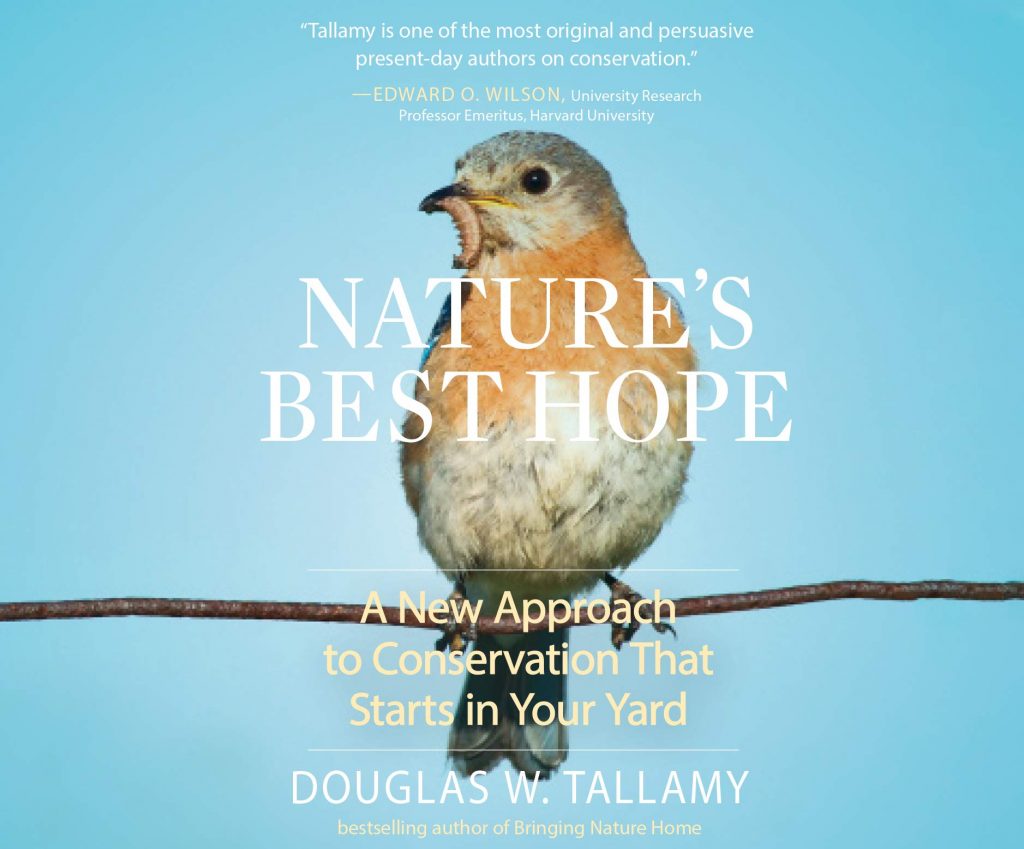As a reoccurring feature on the Sustainability Roundtable blog, we will post reviews of books related to sustainability. Interested in submitting your own review to the blog? Contact August at aolundsmith@gmail.com.

Nature’s Best Hope: A New Approach to Conservation That Starts in Your Yard by Douglas W. Tallamy (Timber Press; 2020)
Book review by Mary Callahan, Children’s Librarian, Hunters Point Library Environmental Education Center, Queens Public Library, NY
I hate gardening. Although I love the idea of growing plants and flowers, my allergies turn the actual work of planting and weeding into eye-itching, nose-dripping, sneezing-inducing misery. But after reading Nature’s Best Hope by Douglas W. Tallamy, I am already plotting out the new native-plant garden that will replace half my front lawn this spring.
That’s because Tallamy, a professor of entomology and wildlife ecology at the University of Delaware, provides a concrete response to the question asked by many people who are concerned about conservation, habitat loss, and the increasing rate of extinction: What can I do?
It turns out there’s a lot you can do.
Tallamy takes the issue of conservation out of the realm of government or national organizations and into the scope of the individual, particularly individual landowners. It’s not enough to preserve natural habitats and fight extinction in protected parks and preserves, he argues. As important as these places are, they are too small and separated from one another to protect species in the long run. People must create a space for nature—insects, birds and other animals, and the plants that they need to survive—literally in their own backyards. And in their front yards, too.
To accomplish this, Tallamy proposes shrinking an all-American symbol—the green, manicured grass lawn. We must replace turf grass, which supports virtually no life, with native plants that are the foundation of a healthy habitat, he insists. If all American landowners made it a goal to convert half of their lawn to “productive native plant communities,” it would restore “some semblance of ecosystem function to more than twenty million acres of what is now ecological wasteland,” a space bigger than the combined areas of the Everglades, Yellowstone, Yosemite, Grand Teton, Canyonlands, Mount Rainier, North Cascades, Badlands, Olympia, Sequoia, Grand Canyon, Denali, and Great Smoky Mountains National Parks.
The result would be, in effect, the country’s largest park system, which Tallamy has dubbed “Homegrown National Park.” This network of private-yard habitats would not only provide food and shelter to the creatures that are being denied a place to live by human development, it would also create “biological corridors” between larger nature preserves, providing a way for animals to move when faced by food shortages, over-population, or other threats. Tallamy writes, “Envision your property as one small piece of a giant puzzle, which, when assembled, has the potential to form a beautiful ecological picture.”
Tallamy understands that Americans love their lawns, and he acknowledges and addresses objections in a style that is direct, conversational, and at times exasperated. He devotes the last chapter of the book to answering potential questions about his approach, covering everything from Lyme disease to homeowners-association regulations.
In addition to making his theoretical case, Tallamy, who also wrote Bringing Nature Home: How You Can Sustain Wildlife With Native Plants, provides lots of useful information and resources for those (like me) who would like to help make Homegrown National Park a reality. For instance, just replacing grass with petunias and impatiens is not enough, gardeners may be dismayed to learn. Many insects need specific plants to survive, and they are not the imported ornamental plants that are the mainstays of American yards. That means replacing manicured lawns with plants that are commonly considered weeds. Monarch butterflies, whose numbers are diminishing at an alarming rate, must have milkweed and nothing else will do.
Among Tallamy’s other (very doable) recommendations for property owners: remove invasive plants, “treasure your leaf litter,” avoid insecticides and herbicides, and don’t mow in the evening, to protect nocturnal species.
For city dwellers who have no grass to convert, Tallamy points out that the lawns of schools and other public properties could also be transformed into native plant gardens by committed community members. He doesn’t specifically mention libraries in this context, but some libraries have already embraced this challenge. An article about library butterfly gardens appears in the Trends section of the March/April 2021 issue of American Libraries. Nature’s Best Hope makes a persuasive case that all of us—libraries included—have a part to play.
Discussion questions:
- Do you think the idea of a Homegrown National Park is viable? How could individuals help make it a reality? What are some roadblocks?
- How can city dwellers and others with no private outdoor space contribute to this approach?
- What specific role can your library play in creating Homegrown National Park?